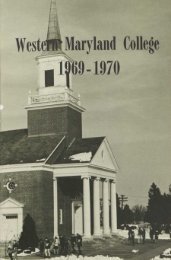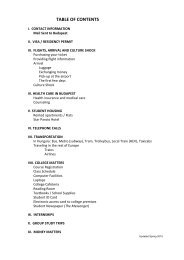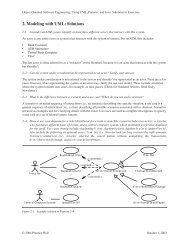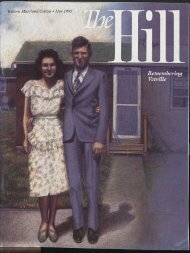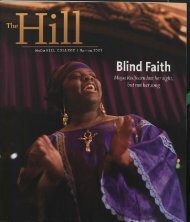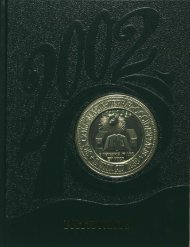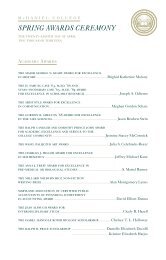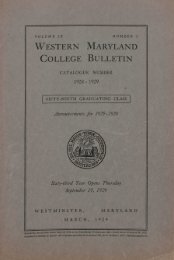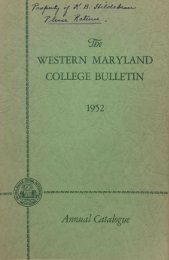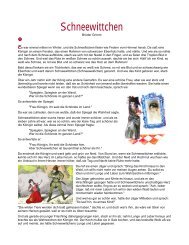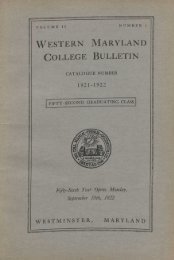Realty duo re'sound'ing hit - Hoover Library
Realty duo re'sound'ing hit - Hoover Library
Realty duo re'sound'ing hit - Hoover Library
Create successful ePaper yourself
Turn your PDF publications into a flip-book with our unique Google optimized e-Paper software.
RON TAfT, assistant professor of<br />
sociology, started something four years<br />
ago ~hich is slowly but certainly catching<br />
on In the student ranks at Western<br />
Maryland. He become a Big Brother.<br />
As of today, seven WMC undergraduate students<br />
have joined Tail as Big Brothers or Big Sisters, each<br />
assigned to a youngster in need of a mature and often<br />
stabilizing friend-relationship. Open to children 6-18<br />
from single-parent homes, the program seeks to build<br />
the self image of each child over a period of time - to<br />
let each child know, according to Mrs. Carol<br />
Kershner, field director in the Carroll County area for<br />
Big Brothers/Big Sisters of Central Maryland,<br />
"another person cares about what he's going through<br />
enough to come back," and cares enough to stand by<br />
him when he needs a friend.<br />
"Until last school year, no more than two students<br />
at any given time were involved with the program,"<br />
says Carol. "Now that's accelerating and I believe<br />
Dr. Tait has made the difference."<br />
"I'd been aware of the Big Brothers program for a<br />
number of years," explains Dr. Tail whose Little<br />
Brother is now 16. When Ron was first matched with<br />
his Little Brother, the two spent their days together<br />
swimming, bowling, throwing a football and playing<br />
pinball. They also went sledding together and Ron<br />
learned about the advantages of waxing the runners<br />
from his Little Brother. "It gave me the chance to do<br />
something other friends my own age were not<br />
interested in," he muses. "<br />
As the two grew closer in their relation~h,I~, their<br />
time was spent less on fun and school acnvnres an.d<br />
more on projects intended to help the youth as hIS<br />
interests moved closer to the work world. Together<br />
they tackled repair projects and dabbled in carpentry<br />
and brick work. When the youth opted out of school,<br />
Dr. Tait tried to help him find employment. Now,<br />
even though the young man has entered the work<br />
force, he still occasionally calls Ron who explains, "I<br />
help out by being there and doing things that an older<br />
brother might do. He really is an awful neat guy -<br />
he's got his own way of doing things."<br />
As Mrs. Kershner points out, each relationship in<br />
the program is unique. Contrasting Dr. Tait's match is<br />
the match between sophomore math major Pam<br />
Huffington of Churchville, Md., and her Little Sister,<br />
Pam learned about the program through Dr. Tait.<br />
At the time of Pam's decision to become a Big<br />
Sister 1 1 ,12 years ago, her soon-to-te Little Sister's<br />
family was new to the area. The mother, concerned<br />
about her lack of time for her daughter, contacted Big<br />
Brothers/Big Sisters. A frequent visitor now to her<br />
By Cindy O'Neal<br />
Keefer<br />
Little Sister's home, Pam is often invited to join the<br />
family for dinner and is pleased to admit that when the<br />
mother talks to friends, she refers to Pam as her<br />
daughter's<br />
sister.<br />
We get along real well," says the attractive,<br />
soft-spoken coed of her Lillie Sister's mother. "We<br />
have from the start. I know she trusts me."<br />
According to the program director, Pam',s<br />
relationship with her Little Sister's fam.ily IS<br />
representative; most parents are very happy With th,e<br />
rogram. "They probably give us much more credit<br />
ihan we're really due," Kershner adds of the<br />
prevailing positive attitude. .'<br />
Pam also enjoys visits from her LIttle Sister.<br />
"That's something neat - bringing her to sch~1<br />
activities," she says explaining that the once shy child<br />
now opens up around her college f~e.n~s, Together<br />
they work on crafts and seasonal acnviues. . .<br />
Although Pam sees herself as a ~riend -:a big sister<br />
_ rather than a counseior, she IS conscious of her<br />
Little Sister's needs and problems. "I basically know<br />
what's going on in the family, they're honest with me<br />
and it helps me to deal with her."<br />
Ed DeWitt became a Big Brother through contact<br />
with Joe Della Badia, '80, and his Little Brother who<br />
sat on the sideline with Ed during Joe's baseball<br />
games.<br />
Ed and his 10-year-old Little Brother of several<br />
months spend time throwing a football, watching<br />
weekend sports and visiting the gameroom. "And he<br />
wants to show me around the town some day,"<br />
DeWitt<br />
adds.<br />
The junior social work major from New Jersey<br />
spends four to 10 hours a week with his Little Brother<br />
"I consider myself a gung hojock," laughs Ed, "yet<br />
here's a little boy who's way ahead of me. He's been<br />
photographed with half of the Baltimore Orioles; and<br />
I've never known someone with so many baseball<br />
cards!" Continuing, Ed adds, "We're just friends<br />
right now but 1 think as time goes on it'll develop into<br />
more of a brother-brother relationship."<br />
Sixteen boys and nine girls in the Carrol! County<br />
area are currently matched with volunteers according<br />
to Mrs. Kershner, yet that does not nearly meet the<br />
need. Although there are enough Big Sisters<br />
available, the local program is so drastically short of<br />
Big Brothers that Carol cannot even accept referrals<br />
let alone place the boys currently on her waiting list<br />
She is pleased with the response from the WMC<br />
community. Although 21 is the stated age limit for<br />
volunteers, exceptions based on individual maturity<br />
are frequently made. "In my work with the students<br />
here, they make up in enthusiasm for what they lack<br />
in experience. On the whole, I have really been<br />
impressed with student volunteers," she says,<br />
explaining that each volunteer is expected to be<br />
committed to the match for at least a year, to see his<br />
Little Brother for at least four hours a week, and to<br />
remain in contact over the summer.<br />
In addition to Ed and Pam, other student volunteers<br />
include: Cathy Fiden, 'SO, Jeff Johnson, 'SO, Jo<br />
Della Badia, 'SI, Bruce Reiner, 'SO and Pam Owen,<br />
'81, whose Little Sister is a high school senior.<br />
"College students who are matched can gel<br />
valuable personal experience with actual<br />
involvement," explains Carol. She feels that students<br />
looking to a career in social work have an opportunity<br />
through Big Brothers to learn whether they ..... really<br />
enjoy the field. Stressing again the individual nat~re<br />
of each match, she says, "We really do work WIth<br />
children of all social classes. Divorce <strong>hit</strong>s all classes<br />
-'~~~~~n~sv:~~t;:r~o::;~~~ hardships of time and<br />
pressures," concludes Kershner.<br />
Students are willing. nonetheless, and three are<br />
currently waiting to be matched. As Pam Huffington<br />
says, "I thought it would be something im~rtantreally<br />
worthwhile "" to spend my nme on. T lr<br />
After being a BIg Brother for four years, Dr. at<br />
doesn't hesitate when he has a ch~nce ,t~ ~~~rui: n;~<br />
volunteers 10 the program. For hIm,. B g "<br />
Brother can be heavy, but a lot of it is JUS! sheer fun<br />
News From The Hlll<br />
It just Occurs<br />
By Ralph C. John, President<br />
Recently the local chapter of Pi Gamma Mu.<br />
Ih~. national social science honor society,<br />
initiated new members. Its president invited<br />
me to make a brier statement as a part of the<br />
ceremony. This I was glad to do, particularly<br />
since I was Initiated into one or the four charter<br />
chapters of this society during my own college<br />
days.<br />
Only a few weeks before the Pi Gamma Mu<br />
event, we had one of the most exciting<br />
Saturday afternoons that many of us at the<br />
college can remember. While we knew that the<br />
triennial meeting or the governing body of Phi<br />
Beta Kappa was in sess~on in Ne~ Orleans.<br />
and that we were being nominated for<br />
institutional membership, we did not dare take<br />
anything for granted.<br />
But the welcome call came to Dr. Cornelius<br />
P. Darcy, chairperson of the f'acuhy<br />
petitioning group: You have just been voted a<br />
charter for a chapter of Phi Beta Kappa at<br />
Western Maryland College. Needless to say, for professional responsibilities on the Hill.<br />
the word spread rapidly.<br />
This must never mean, however, that we<br />
These experiences bring up a question that consider ourselves superior or intrinsically<br />
has been sharply debated in recent years. The more important or valuable than anyone else.<br />
question: Is there a place for any variety of If perchance we are any of these, let others<br />
elitism in an academic community<br />
discover the fact and say it. Snobbery is<br />
The background of this question does not offensive and inexcusable. ln fact, it is<br />
need to be labored. There has been a populistic immoral.<br />
thrust since the people movements of the A college. on the other hand, has<br />
Sixties and early seventies that has had a specialized intellectual/cultural purposes.<br />
levelling influence. ln many respects the Excellence in aptitude, motivation and<br />
effects have been good. There is no place, for<br />
performance in relation to these purposes,<br />
example, for rankings of human beings based'<br />
particularly within the college itself. is<br />
on race, birth or relative position before the<br />
legitimately celebrated, So we have honor<br />
law.<br />
societies.<br />
In other respects, however. there are<br />
In 1969, when there was a press to do away<br />
in~erent inequalities in the very nature of<br />
with grades for a pass/fail alternative, and<br />
things. Physical prowess varies from one<br />
when many high schools stopped giving the<br />
individual to another. As many athletic halls of<br />
class rank of seniors to college admissions<br />
fame as there are. some of us could never<br />
officers - even stopped computing rank in<br />
make any of them, how.everhard ~e might try<br />
class - [ attended the annual meeting of<br />
Others will never smg an ana, write a<br />
Omicron Delta Kappa. a leadership honor<br />
worthwhile poem or resolve a Complicated<br />
SOCietyin Washington, D.C. Usually there is<br />
mathematical equation. These are things for<br />
something substantive on the agendas of these<br />
which we have to depend upon each other.<br />
meetings, but not that year for ODK. For two<br />
Western Maryland is in the fortunate<br />
whole days the student delegates, some of<br />
position of being a selective college in<br />
whom had come all the way from California,<br />
admissions and in the screening of candidates<br />
debated doing away with the traditional key.<br />
2<br />
WMC Receives<br />
0BK Charter _<br />
Western Maryland College has. been se~ec:~~<br />
as one of three new chapters ~atlonwlde. y 'al<br />
1979 Phi Beta Kappa Council at the trlenn~<br />
Council meeting on Oct. 20. Our chapter t:W<br />
known as Delta of the Maryland .Cha~lerSims,<br />
receive its charter from camerme S. f Phi<br />
~i~~aPke:~~ca~t~: ~hs~a~~;:~~ ~:~~I~~~~i~S on<br />
M':Ihil Beta Kappa was founded in 1776 at the




